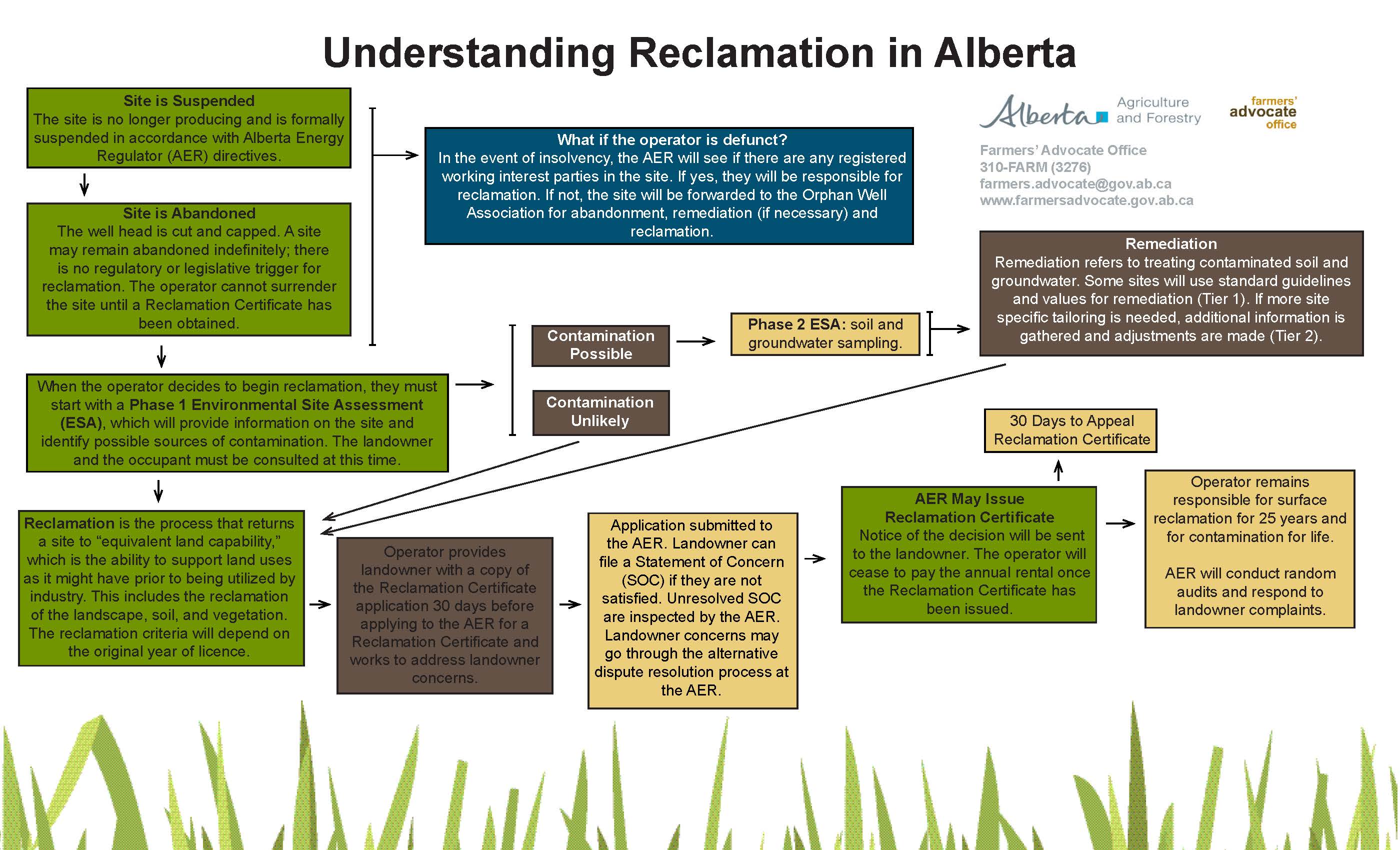| | 
CLICK HERE TO DOWNLOAD A PDF OF THE CHART.
1) Remediation vs. Reclamation
Many people use the words “remediation” and “reclamation” interchangeably. It is important to understand that these are two different things. Remediation refers to the removal or treatment of contaminated soil and groundwater, while reclamation refers to returning a site “equivalent land capability,” which is a condition where it has the ability to support uses as it would’ve prior to being utilized by industry.
2) Landowner Engagement
Landowners (all parties on title) and occupants (renters) will be engaged throughout the reclamation process. Operators are expected to make every effort to address landowner concerns. This engagement starts with the Phase 1 Environmental Site Assessment (ESA), which looks at the history of the site and assesses the possibility of contamination. At this stage, the operator must persistently work to get a hold of the landowner (and occupant, where applicable). Concerns expressed by the landowner and occupant must be investigated and addressed before the application for a Reclamation Certificate is submitted to the Alberta Energy Regulator (AER). Operators are also required to provide all landowners and occupants with a complete copy of the reclamation certificate application package 30 days prior to submission to the AER.
3) Reclamation Requirements
A site's reclamation requirements depend on its construction date, abandonment date and reclamation or re-vegetation date. The Reclamation Criteria for Wellsites and Associated Facilities have evolved from 1995, 2007, and 2010. Any site abandoned prior to 1963 is exempt from the reclamation requirements, so any stipulations related to reclamation would be included in private surface lease agreement. This exemption does not apply to sites that were drilled and still active after 1963.
4) Requirements Based on End Land Use
There are different reclamation requirements based on the end land use: cultivated lands, native grasslands, forested lands, and peatlands. A change in end use from what existed prior to development will require written consent of the landowner.
5) Associated Facilities and Infrastructure
The application for a Reclamation Certificate for a well site must include all associated facilities and infrastructure, such as access roads, remote sumps, camp sites, storage areas, pipelines, etc. A company must obtain the consent of all of the landowners listed on title as well as the occupant when leaving behind any facilities or features, such as access roads or fences. This will only be approved if it is legitimate, logical, and does not pose an environmental risk. Contaminated soil and groundwater cannot be released via landowner consent.
6) No Surrender Until Reclamation Certificate is Issued
An operator cannot surrender the surface lease until it is reclaimed and certified. The landowner should be paid the annual rental in full until the Reclamation Certificate is issued.
7) Landowner to Receive Copy of Application
The landowner will receive a copy of the application for a Reclamation Certificate and have 30 days to review it prior to the operator sending it to the AER. If the landowner’s concerns are not addressed by the operator during the 30 days, the landowner may submit a Statement of Concern to the AER. The AER will investigate the complaint. The application will then be considered “non-routine,” which means a detail review of the application is done and it will be checked both for regulatory compliance and completeness. Mediation between the operator and the landowner is available through the AER.
8) Inactive vs. Suspended vs. Abandoned vs. Orphan
Another common confusion is the difference between inactive, suspended, abandoned, and orphaned wells:
- Inactive: A well that is taken out of production. A well can only remain inactive for 12 months before it has to be formally suspended.
- Suspended: Wells must be suspended after 12 months of inactivity to ensure public safety. Suspension requirements vary depending on the category of risk. Medium and high risk wells will require tubing, and all types will require some form of inspection and reporting.
- Abandoned: For a well to be considered “abandoned,” the well bore must be cut and capped in accordance with the directives outlined by the AER.
- Orphan: An orphan site is one where the where the operator has become defunct prior to suspension, abandonment, remediation, or reclamation, and there are no working interest parties available to undertake these activities.
9) Trigger for Reclamation
There is no required timeline for reclamation in Alberta. An operator may choose to leave a site abandoned indefinitely, but it will negatively affect their Liability Management Ratio (LMR) will the Alberta Energy Regulator (AER), which may result in the need to post a security deposit. Note that an Environmental Protection Order can be issued for reclamation or remediation if an adverse impact to the environment, water, or groundwater is present.
10) Operator Remains Responsible
The operator remains responsible for surface issues unforeseen at time of certification for 25 years after the Reclamation Certificate is issued. They also remain responsible for contamination for life. If you spot problems with reclamation or contamination after a Reclamation Certificate has been issued, you should contact the AER.
Questions? Contact the Farmers' Advocate Office by email at farmers.advocate@gov.ab.ca or through the Ag Info Centre at 310-FARM (3276).
Disclaimer: Information found on this website is intended to be for information purposes, and should be used as a guideline only. Any discrepancies should be forwarded directly to the agency that holds the jurisdiction. |
|